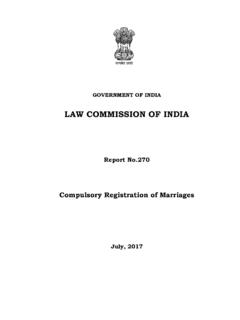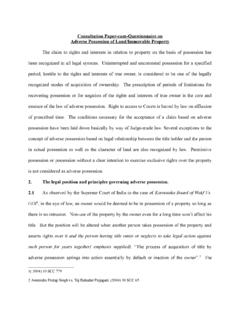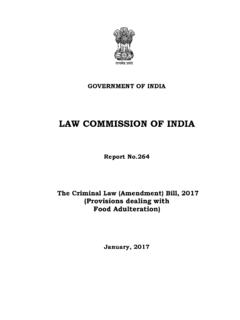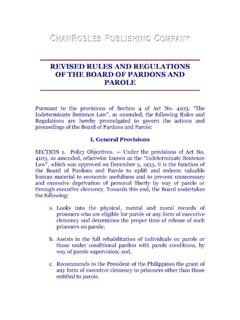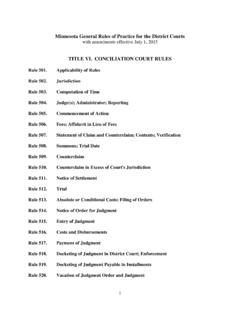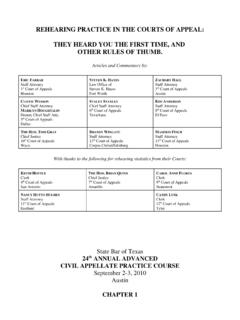Transcription of GOVERNMENT OF INDIA - Law Commission of India
1 GOVERNMENT OF INDIA LAW Commission OF INDIA Report The Advocates Act, 1961 (Regulation of Legal Profession) March, 2017 ii iii iv Report The Advocates Act, 1961: Regulation of Legal Profession Table of Contents Chapter Title Page I Background Inception of the Legal Profession 1-2 II Advent of the Constitution 3-4 III Era of the Advocates Act, 1961 5-6 IV Period of Aberration 7-8 V Judicial Pronouncements and the Law 9-10 VI Law Commission s Initiative 11-12 VII Loss of Courts Working Days : A Staggering Fact 13-14 VIII Supreme Court Judgements on Strike - Reprehensible act 15-23 IX Denouncing the Contemptuous acts of Advocates 24-29 X Propriety of performing public functions by convicted persons 30-32 XI Advocacy Lurking in the shadows 33 XII Legal Education in INDIA 34-39 A Historic Perspectives 35 B Constitutional Framework 35-36 C Reports of previous Law Commissions 36-37 D Legal Position 37-39 E Conclusion 39 XIII Pre-enrolment Training of Advocates 40 XIV Prospects of Foreign Law Firms and Lawyers in INDIA 41-45 XV Need for Defining Misconduct 46-47 XVI The Relevance of Framework of Regulation of 48-51 v Legal Profession in the United Kingdom XVII Need of Reviewing Regulatory Mechanism 52-56
2 Annexures I Bar Council of INDIA Proposed Amendments to the Advocates Act, 1961 57-87 II Analysis of the Responses Received by the Law Commission of INDIA 88-92 III The Advocates (Amendment) Bill, 2017 93-112 1 CHAPTER-I Background Inception of the Legal Profession The dawn of Legal Profession in our country could be seen in the Indian High Courts Act, 1861 (commonly known as the Charter Act) which authorised establishment of the High Courts under the Letters Patent and those Letters Patent empowered the High Courts to make rules for enrolment of Advocates and attorneys who were also known as solicitors. In the early days three Acts, namely, the Legal Practitioners Act, 1879 (18 of 1879), the Bombay Pleaders Act, 1920 (17 of 1920) and the Indian Bar Councils Act, 1926 (38 of 1926) relating to legal Practitioners were enacted.
3 The importance of legal profession in the Judicial Administration while dispensing justice with the aid of those who could effectively present the case of a litigant, was designed to usher in bringing the rule of law. The legal profession was acknowledged as the noble profession as it catered to, and contributed to lay the firm foundations of a system that dispenses fair and impartial justice. The desire of common man to receive justice was taken care of by making provisions for the presentation of a case and its redressal through persons in whom trust was reposed. Roscoe Pound, an eminent jurist states that historically, there are three ideas involved in a profession: organization, learning, and a spirit of public service.
4 1 While considering these elements essential, he states that the idea of gaining a livelihood through profession is nothing more than an incidental element. However, amongst the three elements, the most important with regards to a profession is the spirit of public service. The ethical compunctions of the professionals are similarly exemplified in a 1 Roscoe Pound, What is a Profession - The Rise of the Legal Profession in Antiquity , 19 Notre Dame L. Rev. 203 (1944), at p. 204. 2 European Union Directive in which liberal professions were described as those practised on the basis of relevant professional qualifications in a personal, responsible and professionally independent capacity by those providing intellectual and conceptual services in the interest of the client and the public 2 (emphasis added).
5 In this background, the founding fathers of our Constitution while adopting a federal governmental system, entrusted a duty on the judiciary to strike a balance between the functioning of the other organs of the GOVERNMENT while protecting the life and liberty of the citizens. With the avowed objective of conforming to the rule of law and dispensation of justice as contained in it, the elements of a perfect system of constituting courts on different tiers together with the system of advocates in the legal profession, who have been conferred with right to practice under the Constitution which now stands embedded in the Advocates Act, 1961 (hereinafter referred to as the Advocates Act).
6 2 Directive 2005/36/EC of the European Parliament and of the Council on the Recognition of Professional Qualifications (7 September 2005). 3 CHAPTER-II Advent of the Constitution Our judicial system is enshrined in the Constitution with powers to dispense justice, including their constitution and jurisdictions, and with powers to make their own rules. The Supreme Court has been described as a court of record and conferred with all powers including the powers to punish for its contempt under article 129 of the Constitution. The power to frame rules, subject to the provisions of any law made by Parliament and with the approval of the President, has been conferred on the Supreme Court under article 145 of the Constitution.
7 Sub-clause (a) of clause (1) of article 145 specifically empowers the Supreme Court to frame rules regarding the persons who can practice before it. There exists a distinction in the conferment of powers on the High Courts. While conferring the powers on the High Courts, rules as to the persons practicing before the Court have not been provided for under the Constitution as compared to the Supreme Court referred to hereinabove. The power to enact a law pertaining to the right to practice before a High Court has been retained under Entry 78 of List I of the VIIth Schedule to the Constitution, with Parliament itself. However, the High Court, being a court of record and has been conferred with powers to punish for its contempt under article 215 of the Constitution.
8 This article has significance as it confers the power in relation to the proceedings of criminal contempt that extends to awarding a sentence of punishment in the event of a breach by an advocate vis- -vis his professional misconduct in the Court. The power, however, to frame a law on contempt and to make provisions for the same are available with Parliament 4 and the State Legislatures under Entry 14 of List III of Schedule VII to the Constitution. The expression administration of justice also occur in Entry 11-A of List III (Concurrent List). Whenever, it comes to taking a broad view of the terminology aforesaid, the same can also include within its fold the role of advocates in the administration of justice.
9 Entry 13 of List III, empowers Parliament as well as the State Legislatures to frame rules regarding procedure. Order 3 Rule 1 of the Code of Civil Procedure, 1908 and section 303 of the Code of Criminal Procedure, 1973 make exhaustive provisions for representation of litigants through recognised agents and pleaders. Thus, the statute has given a legal status to the participation of an advocate in judicial proceedings. Separate sets of rules govern engagement of advocates as empaneled lawyers on behalf of the Central GOVERNMENT and State Governments as well as their undertakings and such other bodies that are within their control. Thus, the presence of advocates as part of the justice delivery system is ingrained in our laws.
10 With this in view Entry 26 in List III of Schedule VII was incorporated in the Constitution, empowering Parliament and the State Legislatures to frame laws with regard to the legal profession as well. 5 CHAPTER-III Era of the Advocates Act, 1961 With the passage of time, it was felt that the Judicial Administration should be changed according to the needs of the time. The First Law Commission examined and made a Report on Reforms of Judicial Administration. The All INDIA Bar Committee also examined the matter and made its recommendations in 1953. To implement the recommendations of All INDIA Bar Committee after taking into account the Law Commission s recommendations made in its Fourteenth Report in so far as they relate to the Bar and to legal education, the Advocates Act was enacted.




